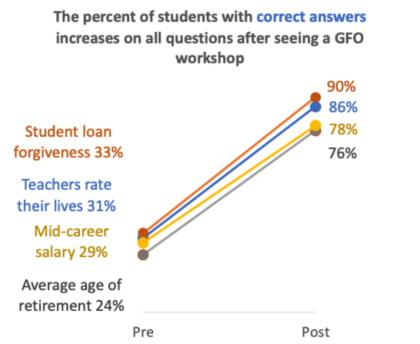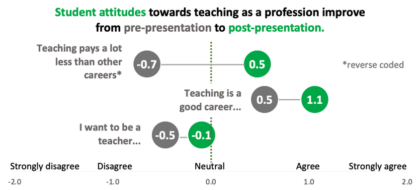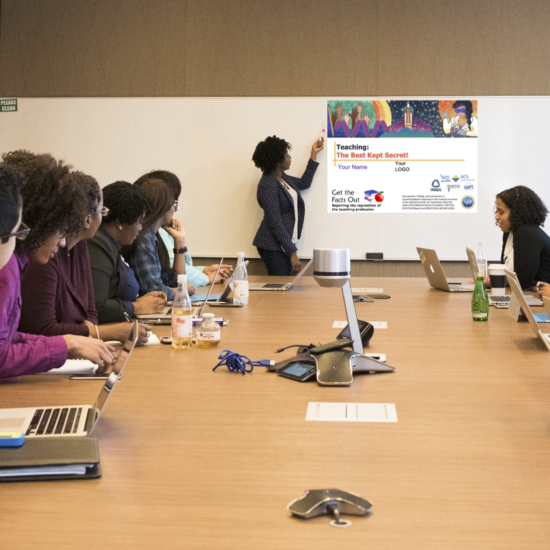GFO student presentations are highly effective.
One of the most popular GFO resources is a series of student presentations (“Busting Myths about the Teaching Profession”) aimed at conveying facts about teaching careers. Across a large number of students, we find that these presentations not only convey the facts, but lead to positive changes in perceptions. As GFO external evaluator, I recently pulled together a large data set of the project impacts to date; this is last of three posts about what I’ve found in those analyses. (The other two are about the presentation for faculty and GFO’s impressive reach.)
Those using GFO presentations can see clear, demonstrable impacts on students.
In a survey of 58 GFO Champions, about half were able to list clear, demonstrable impacts of using GFO’s student presentations — including recruiting students to the profession. Sample quotes:
As a direct result of seeing a GFO presentation, students have come to talk with me to learn more about the teacher preparation program.
We have seen an increase in the number of STEM students adding a major in secondary education.

Participants in student workshops demonstrate clear and consistent gains in knowledge and perception.
Each GFO student presentation or faculty workshop includes a pre/post survey which includes questions testing factual knowledge about teacher salary, retirement, etc., as well as asking about perceptions of the teaching profession. A percentage score is assigned based on factual correctness or desirability of the answers. Averaged across 54 student presentations (N=1,605 attendees), pre-post scores increase dramatically: from 31% pre-presentation to 72% post- presentation, for an average gain of 41% (effect size 1.9) and normalized gain of 54%. These are impressive results. The pre-post data on correct answers, and perception change, are shown below.


One-third of students shift towards greater agreement with “I want to become a grade 7-12 teacher.”
While the overall average of agreement with the statement “I want to become a grade 7-12 teacher” does not shift dramatically, I wanted to know how many students shift their attitudes to being more positive. Across 1,657 students, one-third of students (N=553) shifted towards a more positive attitude, and 7% had a large shift in response (moving up more than one level). These shifts are due to fewer students disagreeing, and more students who agree or are neutral. Since GFO aims to reduce the barriers to students deciding to become a teacher, shifts in attitudes and understanding are very positive.
It’s important to customize your materials with local data.
One finding that concerns the project is that many Champions are not locally customizing GFO materials with their program information or local teacher salary and retirement data. Since local data is critical to the credibility and persuasion of the materials, this customization is important. This lack of local customization may be the reason that Champion student presentations have lower normalized gains (43%) than do presentations by GFO staff (59%). GFO has collected local data from hundreds of districts around the country, which is available on the Teacher Salary Data page.
Student presentations are popular – but can be even more widely used!
Among the GFO materials, the student presentations are the most commonly used by Champions, and they are among the top downloaded items on the website. Most use them in structured venues, like classrooms, student clubs, or advisor meetings. GFO Champions conducted a total of 93 (!) student presentations in 2021-2022 alone, reaching over 2200 students. However, only about ⅕ of Champions have actually conducted a student presentation. Just imagine the reach possible if even more start to make use of this valuable and effective tool! If you want some ideas about how it’s been used successfully, check out this recent blog post or ask a question on our GFO community listserve.



